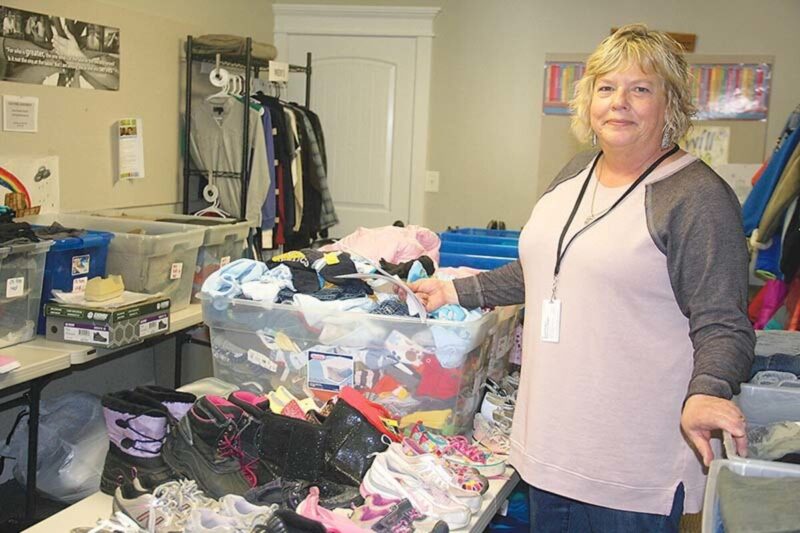Sean C. Morgan
Of The New Era
Sweet Home School District Homeless Liaison Kristi Walker told the School Board that the district had 285 students identified as homeless in 2018.
That’s roughly 12 percent of the student population and an edge up from the previous year’s rate of about 10 percent. Among Oregon districts with more than 1,500 students, only Lincoln County had a higher rate, nearly 12 percent, in 2017-18.
Walker and Supt. Tom Yahraes gave a report on homelessness in the district Monday evening during the regular School Board meeting.
The district counts as homeless all youths under the age of 18 who share housing with another person due to a loss of housing, economic hardship or a similar reason, Yahraes said. That’s referred to as “doubling up.” They also may live in motels, trailers, parks, campgrounds, shelters, vehicles and tents.
Nationwide, about 2.5 million students are defined as homeless, Yahraes said. Some 76 percent of them are doubled up with other families, and 14 percent live in shelters.
Oregon ranks first in the nation for the rate of homeless children, he said. Among those homeless, nearly 50 percent of them will not graduate, with a lower graduation rate than for students with disabilities, who graduated at a rate of 58.8 percent in 2016-17.
Approximately 40 percent of homeless students are chronically absent, missing 10 or more days of school in a year, Yahraes said, and homeless students are much less likely to meet or exceed state standards, with about 29 percent meeting the language arts standard in 2016-17, compared to 54 percent among all students, and 18 percent in math, compared to 41 among all students.
Homeless students are absent more frequently, Yahraes said. They’re four times more likely to have developmental delays and twice as likely to have learning disabilities. They perform lower academically and drop out more frequently.
Homeless students lack food, shelter, warmth and basic clothing, he said. They often feel unwanted, unsafe, unloved and unwelcome. They often face abuse, neglect and trauma, while having fewer friends and positive social supports.
Those needs must be met before learning can take place, he said. “Those are the building blocks.”
Research shows that schools can have an impact, Yahraes said. Among them are after-school tutoring, focusing on chronic absenteeism, training counselors in homeless services and resources, and creating interdisciplinary teams to help address academic, social, emotional, behavioral and basic needs.
In Sweet Home, the majority of homeless students are doubled up, Walker said. A few are living in homes with four to five families. Some live in vehicles, campgrounds and public lands.
One family with three school-aged children must change its location every 14 days, based on camping restrictions, Walker said. The family has a pay-as-you-go phone, which is frequently out of minutes. That makes it hard for the district to transport the children to school.
What little money the family has, Walker said, may be spent occasionally on campgrounds so the children can get a shower.
Now “the rains are starting,” Walker said. “It’s not as warm.”
A lot of families are also in campers and tents on private property, Walker said. Some live in abandoned houses and buildings.
They don’t have incomes to afford rents, Walker said, and in many cases there is no housing available at all. That’s a problem around the state.
Walker manages a closet where about 20 children per week can come and get clothing and supplies. The district helps families obtain needed documents and school records, and it provides schools, which are safe places for the children.
The district partners with Sweet Home Emergency Ministries to ensure the students and their families have food at the holidays. Entek provides coats for homeless children. The district also facilitates health navigators to help families sign up for the Oregon Health Plan through Walker’s closet program.
The district works with a Youth Services Team, representatives of various organizations and agencies, to help the homeless youth, Walker said. The community last year started using a similar process with the same organizations, the Adult Services Team, to assist the homeless or those about to become homeless.
Decades ago, “for most of them, it was temporary,” said School Board member Debra Brown. Most of the time, homelessness would last a few months.
“We’re not seeing that any more,” Walker said. The homeless are chronically so, and “there’s not a lot you can do for them.”
“I absolutely think public education is a mechanism that can change the cycles and address this,” Yahraes said. To do that, he wants the district to continue its tutoring programs and focusing on chronic absenteeism, and he wants to improve professional development for counselors.
“We want to enhance Kristi’s work,” Yahraes said, noting that Foster is implementing an interdisciplinary team this year as a pilot for the district under the leadership of Foster School Principal Luke Augsburger.
Present at the board meeting were Jim Gourley, Jason Van Eck, Chanz Keeney, Mike Reynolds, Brown and Angela Clegg. Absent were Chairman Jason Redick and Jenny Daniels.
In other business, the council:
n Approved the hiring of Greg Nathan as a temporary advanced math teacher at Sweet Home Junior High and Tenille Sayer as a temporary .75-full-time equivalent teacher on special assignment at Holley Elementary.
n Approved updates the district’s homeless policy and questionnaire.
n Approved the district’s Healthy and Safe School Plans, a requirement of the state government. Among the provisions in the plan are testing schedules for lead and radon. It also address asbestos, pest management and carbon monoxide detectors. Test results may be found at sweethome.k12.or.us/our-district/public-reports.





